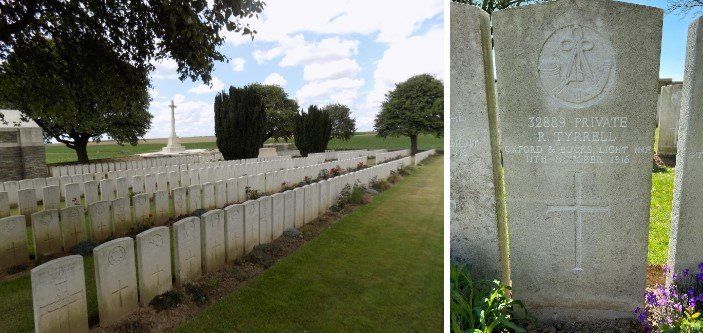In Memory of
RICHARD TYRRELL
Born: 1874 Steventon, Berkshire.
Son of William and Esther Tyrrell of
Stocks Lane Farm, Steventon.
Husband to Ann, Father of 3 children
Pre-war occupation: Farmer/Land Owner
32889 Private Richard Tyrrell
6th (Service) Battalion, Oxfordshire & Bucks Light Infantry
Died: 9th to 11th October 1916 aged 41
Died of wounds received in action:
(Between Ginchy & Le Transloy) Somme, France
REMEMBERED WITH HONOUR:
Grove Town British Military Cemetery
Meaulte, Departement de la Somme, Picardie, France. Plot I. O. 11.
Also remembered on his Parents headstone, St Michael’s churchyard

COMMEMORATED IN PERPETUITY BY THE
Commonwealth War Graves Commission
The Imperial Yeomanry was a British volunteer cavalry regiment, formed on 2nd Jan 1900, that mainly saw action during the Second Boer War (1899-1902) in South Africa. Richard enlisted in Reading, at its inception (aged 25). Private Richard Tyrrell was attached to the 39th (Berkshire) Company, 10th Battalion and landed in South Africa on 28th April. He was involved in campaigns at Lindley, Bethlehem and Boshof through 1900. However, on 25th Feb 1901 he was discharged from service 'at his own request' in connection with the war in South Africa. It is not known why Richard requested to be discharged, but it was at the start of 1901 when the British confined Boer families and black Africans in a network of concentration camps. As well as removing a means of support for the guerrilla army, it was believed the presence of Boer families in the camps would make soldiers in the field surrender. Women and children were rounded up and farms were destroyed. Accommodation in the camps was poor. Water and food were in short supply, and medical and sanitary facilities almost non-existent. Sickness became widespread. In all, 28,000 Boers, mainly women and children, died in the camps. Around half that number of black Africans also died in separate camps. With Richard's background as an ordinary British farmer, this new tactic of forced encampment of the farming families may have been too much for him to bear.
On 2nd Nov 1915 (aged 40yrs 11mths) Richard enlisted for a 2nd time, this time to the ASC Remounts Service, which was responsible for the provisioning of horses and mules to all other army units. However, it was short lived as he was discharged at Romsey, Hampshire just 8 days later, on 10th Nov 1915 - as "being unlikely to become an efficient soldier“.
In 1916, Richard signed up for a third time, at Kings Lynn, Norfolk! This time with the Queen's Own Oxfordshire Hussars and was shipped out to the Western Front. At this point, during the heavy trench warfare at the front, Infantry divisions were more useful than cavalry, and so Private Tyrrell was transferred to the Oxfordshire & Buckinghamshire Light Infantry, 6th Battalion. The 6th were in action at The Somme - The Battle of Delville Wood, The Battle of Guillemont, The Battle of Flers-Courcelette, The Battle of Morval and The Battle of Le Transloy. It was in the area of Le Transloy that Private Tyrrell received the wounds that eventually killed him. A total of over 57,700 British troops lost their life, on The Somme in October 1916 alone.
In September 1916, the 34th and 2/2nd London Casualty Clearing Stations were established at a point, known to the troops as Grove Town, to deal with casualties from the Somme battlefields. They were moved in April 1917 and, except for a few burials in August and September 1918, the cemetery was closed. Grove Town Cemetery contains 1,395 First World War burials. Widow Ann (Annie) Mary Hayden. Children - Violet Hayden, Winifred Mary, Richard William. Date of death is also listed as 11th October in some records.
Richard Tyrrell's father's line can be traced back to at least 1758 as Farm/Land owners in Steventon. At various points the Tyrrells have owned five separate Farm properties during their time in Steventon. Richard was the middle child of 7 - 3 Brothers and 3 Sisters, born to William and Esther Tyrrell. Richard inherited Stocks Lane Farm from his father, in 1909 and lived there with his wife, Annie Mary Hayden and their 3 children, until his death in 1916. When their father died they were aged: Violet Hayden (12), Winifred Mary (8), Richard William (6). After Richard's death, Annie left Steventon some years later and emigrated to Australia. Robert Tyrrell of The Manor House, Steventon keeps the family farming tradition going today.
For additional information regarding this soldier and his family. Please click here